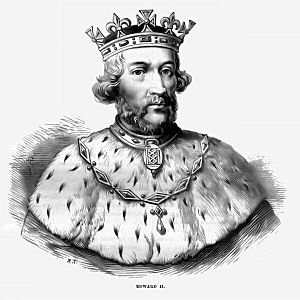Battle of Old Byland facts for kids
The Battle of Old Byland (also known as the Battle of Byland Abbey or Battle of Byland Moor) was an important fight between Scottish and English armies. It happened in Yorkshire, England, in October 1322. This battle was a key part of the Wars of Scottish Independence. The Scots won a big victory, their most important since the Battle of Bannockburn in 1314.
Quick facts for kids Battle of Old Byland |
|||||||
|---|---|---|---|---|---|---|---|
| Part of First War of Scottish Independence | |||||||
 Edward II- by Cassell |
|||||||
|
|||||||
| Belligerents | |||||||
| Commanders and leaders | |||||||
| Strength | |||||||
| Unknown but substantial | Unknown but substantial | ||||||
| Casualties and losses | |||||||
| Low | Heavy | ||||||
Scotland Fights Back
After Robert the Bruce won the Battle of Bannockburn in 1314, the Scots started taking control of the war. They often raided deep into northern England. Their goal was to make the English agree to peace talks.
The English king, Edward II, struggled to handle these raids. He was often busy with arguments and disagreements with his own powerful nobles. King Edward also refused to recognize Robert the Bruce as the rightful King of Scots.
In early 1322, things got very serious. Some important English nobles, led by Thomas of Lancaster, even thought about joining forces with the Scots.
Robert the Bruce didn't trust Lancaster much. But he quickly used this chance to his advantage. A truce (a temporary stop to fighting) ended in January 1322. Soon after, Scottish commanders Sir James Douglas, Thomas Randolph, and Walter Stewart launched a big attack. They spread out across the north-east of England. Douglas went to Hartlepool, Moray to Darlington, and Stewart to Richmond.
Lancaster, with his army, did nothing to stop them. King Edward ignored the Scots. He told his commander in the north, Sir Andrew Harclay, to focus on fighting the rebellious nobles instead. Harclay finally defeated these nobles at the Battle of Boroughbridge. After this, the Scottish raiders safely returned home.
King Edward's Big Plan
The victory at Boroughbridge gave King Edward new confidence. He had defeated the nobles who opposed him. Feeling strong, he decided to invade Scotland one last time. But this invasion turned out to be a disaster.
By the time Edward was ready to attack in early August, Robert the Bruce was prepared. Bruce used his usual clever tactics. His army destroyed crops and moved all farm animals away. The Scottish army then pulled back north of the River Forth. In the entire region of Lothian, the English supposedly found only one lame cow. The Earl of Surrey joked, This is the dearest beef I ever saw. It surely has cost a thousand pounds and more!
Sir Thomas Grey, a writer from that time, described the whole English campaign. He said the English army marched to Edinburgh. There, at Leith, many soldiers became sick and starved. They had to retreat because they ran out of food. Scottish light horsemen also defeated some of the king's troops. English soldiers were too scared to leave the main army to find food. They were so tired from fighting that many animals in the army died before they reached Newcastle. Because of this, the army had to break up.
In revenge, the English destroyed Holyrood Abbey in Edinburgh. They also ruined the border abbeys of Melrose and Dryburgh. But the invasion achieved nothing. The terrible retreat of a starving army hurt England's morale almost as much as the defeat at Bannockburn. Even worse, an English retreat always meant another Scottish attack was coming.
The Battle of Old Byland
Robert the Bruce crossed the Solway in the west. He moved southeast towards Yorkshire, bringing many soldiers from Argyll and the Scottish Isles. This attack was very bold and fast. It quickly put King Edward in danger on his own land.
After returning from Scotland, King Edward was staying at Rievaulx Abbey with Queen Isabella. Their peace was suddenly broken when the Scots arrived unexpectedly in mid-October. The only thing standing between the Scots and capturing the king was a large English army. This army was led by John of Brittany, Earl of Richmond.
Richmond had taken a strong position on Scawton Moor. This spot was between Rievaulx Abbey and Byland Abbey. To force the English off this high ground, Bruce used a similar tactic to his earlier victory at the Battle of Pass of Brander. While Moray and Douglas charged uphill, a group of Highlanders climbed the cliffs on the side of the English army. They then charged downhill into Richmond's rear (from behind).
The English resistance quickly fell apart. The Battle of Old Byland became a complete and bloody defeat for the English. Richmond himself was captured. Other important prisoners included Henri de Sully, Sir Ralph Cobham (called 'the best knight in England'), and Sir Thomas Ughtred. Many other English soldiers were killed as they tried to escape.
King Edward, who was often described as "chicken-hearted and unlucky in war," had to flee quickly from Rievaulx. He left in such a hurry that he left his personal belongings behind. After Byland, Sir Thomas Gray wrote that the Scots were very fierce and their leaders very brave. The English were so scared that it was like a hare running from greyhounds. This was a very important Scottish victory. It came after their success at Myton on Swale and was followed five years later by their win at Stanhope Park over Edward III.

